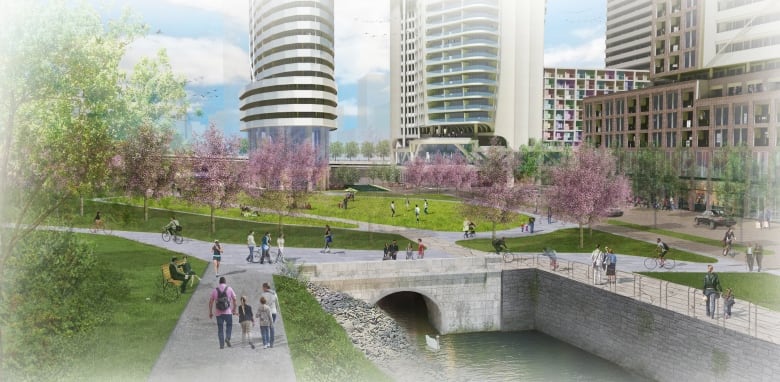Onward and upward: Here's the lowdown on Ottawa's increasingly high hopes
Highrises up for approval Wednesday would be among city's tallest, including one for 65 storeys

In a single meeting Wednesday, Ottawa city council is set to approve three rezoning applications that could add 350 storeysand11 new buildings along what's now a mostly desolateone-kilometre stretch of Albert Street. It's an unprecedented orgy of city building that willrenderthe urban landscape just west of downtown unrecognizable.
The most notable of these dramatic alterations to the skyline may be Trinity Group's proposal for900 Albert St., across from the Bayview LRT station. A single tower comes in at a record-smashing 65 storeys, more than double any existing building in Ottawa today. This application has to get the green light at Tuesday's planning committee before moving along to council the next day.
- Objections to 65-storey tower not all grounded in height
- 'East Flats' still too tall, neighbours complain
- Committee approves library precinct zoning
The other two developmentshave already been approved at planning, and now just need council's stamp of approval.
The city wants to rezone the new central library site, just west of Bronson Avenue, for 12 storeys. The two parcels of land immediately to the westare owned by the National Capital Commission, and were rezoned as part of the same applicationfor 25 storeys each.

Tucked in behind that linear library-NCC stretch of land is a project that's become know at the East Flats, where Claridge Homes plans five highrises one soaring to 45 storeys and opens out onto the Booth Street bridge.
What's the problem with height, anyway?
This week's tall towers decisions have some asking if Ottawa is really a 65-storey sort of town.
For more than a decade, the tallest building in Ottawa has been Westboro's 32-storey Metropole condo tower, soon to be outdone by the 45-storey Icon tower Claridge is now building in Little Italy.
Mayor Jim Watson had promised residents certainty in planning, and we certainlydon't have that.
Are we really ready to go evenhigher?Who knows? Nobody has asked.
There have been no formal planning discussionscontemplatingthe wisdom of the cluster of towerscouncil is poised toapprove. Council is reacting to developers' proposals instead of asking them toinnovate within the bounds set out by the city.

Vertical subdivisions
And here's a simple question: Dopeople actually want to live in these tall towers?
The evidence so far suggests ambivalence at best. Claridge's 45-storey Icon has been in development for years, but is barely half sold, according to the project's own website. Like many North American cities with little history of families raising kids in apartments, we appear attached to our single-family home culture. Ottawa's population at end of 2016 reached nearly970,000, and most of the recent growth was outside the Greenbelt.
So what is the city doing to attract people to these downtown towers?
Of course, there's the massive investment in the transit system, used as a rationale for any amount of development you have to crane your neck to see. But transit is extending into the suburbs, so it balances out.
And where's the social and public planning for these developments? As Michael Powell, president of the Dalhousie Community Association,put it regarding 900 Albert, the city is approving a "vertical subdivision"without the amenities that go into a traditional suburban development.
Where are the amenities?
Consider the contrast: at its Tuesday meeting, the planning committee will review a new subdivision for Stittsville. The planned 400 detached home and 350 townhomes will come with"three parks, a school site and a stormwater management pond."
In other words, future public amenities like parks and a school are clearly identified to match the residential growth. Yet council is set to approve 3,000 homes for the Albert Street area at its Wednesday meeting, and there are no specifics about where any community centre, new school, or parks will go. The proposal for East Flats includes vague plans for a linear park, but it hasn't been funded.

The centrepiece of their vision is a new NHL arena, but RendezVous also has plans for significant green space, a community centre catering to those with disabilities, and a French public school. All laudable goals but far from a done deal.
The pattern forming for this key parcel of downtown looks like this: the developers drive the changewhile the city planners getpulled along in their slipstream.
How high does Ottawa really want to climb? How will the amenities taken for granted in the suburbs be added where verticality defines new neighbourhoods? These are questions being asked too late for the answers to matter.












_(720p).jpg)


 OFFICIAL HD MUSIC VIDEO.jpg)
.jpg)



























































































